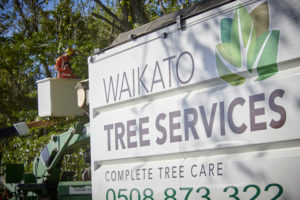Trees & power lines
Managing trees is a community responsibility
Trees growing close to power lines and other electrical conductors pose a severe risk to public safety. They may also cause power cuts or voltage problems for connected consumers.
In Waipā, trees account for about 25% of unplanned network outages each year. This can be from fallen trees, branches, bark and other debris on power lines.
You may not know it, but as a property owner, you are responsible for keeping the trees growing on your property clear of overhead power lines and underground cables.
Together, we can keep trees clear of powerlines, reduce the number of unexpected power outages and keep everyone safe.
![]()
As property owners, there are regulations in place to ensure power lines are kept clear of trees and risks are minimised.
![]()
Under the Electricity (Hazards From Trees) Regulations 2003, we are required to issue notices to tree owners if we identify the vegetation growing within the set distances.
The regulations
In October 2024, The Electricity (Hazards from Trees) Regulations 2003 were updated to increase the minimum safe distances between trees and power lines, and a new ‘clear to the sky’ requirement for some trees.
The regulations include:
- Any tree or vegetation that is considered a risk to our power equipment
- Minimum safe distances between trees and power lines (Growth Limit Zones)
- Responsibilities on tree owners and line owners for ensuring that clearances are maintained
- Setting out the penalties that each party faces for failing to comply with the regulations
- Outlining the arbitration process for handling disputes between tree owner and line owner.
The regulations define four zones:
Growth Limit Zone: This is the minimum distance that trees must be kept clear of overhead power lines.
Cut-back Zone: This zone ensures vegetation is trimmed back far enough to prevent it from quickly growing into the Growth Limit Zone.
Notice Zone: We will issue a notice if vegetation is in this zone to give property owners time to address the risk earlier before it becomes urgent.
Clear to the sky: This is the area above the line that must be kept clear.
Fall Hazard Zone: Trees present a hazard if they fall and damage power lines. A tree’s fall hazard zone is the height of the tree plus 4 meters.
Note: Fall Zone trees are not currently covered by regulatory requirements. But if you own a tree that is within the fall zone and you have concerns about its health or safety, please notify us to discuss your options.
What are the minimum safe distances?
Overhead Line Voltage Growth Limit Zone (GLZ) Notice Zone
The size of the Growth Limit Zone varies depending on voltage level:
| Overhead Line Voltage | Growth Limit Zone (GLZ) | Cut-back Zone | Notice Zone |
| Power lines (230-400 V) | 0.5m | 1.5m | 2.5m |
| High voltage lines (6.6 kV) | 1.6m | 2.6m | 3.6m |
| High voltage lines (11kV) | 1.6m | 2.6m | 3.6m |
| High voltage lines (33 kV) | 2.5m | 3.5m | 4.5m |
The Notice and Growth Limit Zone requirements increase if the adjacent power line span is greater than 150m. In these cases, we will notify you of your obligations.
Meeting the tree regulations
As the tree owner, you may receive a Trim Notice regarding a tree on your property. It is essential to promptly adhere to the regulations outlined in this notice, as failure to do so may result in committing an offence.
- Fail, without reasonable excuse, to cause the tree to be cut or trimmed per the Regulations; or
- Fail, without reasonable excuse, to advise us of the time and location of the tree’s cutting or trimming.
If you do not comply with a notice within the time specified, then you could be:
- Fined up to $10,000, plus $500 for every day the offence continues
- Held liable for costs of repairs if our lines or equipment are damaged by your tree
- Held liable for damage caused by broken power lines
- Held liable for damage caused by any resulting power surges affecting others
Service Mains
A service main connects your property to our network. This typically forms an overhead or underground connection from the street pole to your house.
We do not own this and is not covered by the regulations. You must keep trees clear of this line.
If you need to carry out tree maintenance, we can temporarily disconnect the power. See the safety disconnection page for more information.
Safety disconnections are free if it is no longer than 15 minutes during business hours (a charge applies for 11 kv lines in all cases).
Leave it to the professionals
Waikato Tree Services
Waikato Tree Services has cared for trees in Hamilton and surrounding areas for almost 30 years. Since taking ownership in 2010, Waipā Networks Ltd has grown the company to include three teams of fully qualified and experienced arborists, with a fleet of modern, hi-tech equipment, including an 18.5-metre high cherry-picker. You can contact them for any sized job!
Website waikatotrees.co.nz
Email: trees@waikatotrees.co.nz
Tel: 0508 87 33 22
